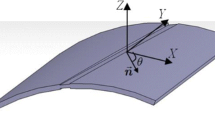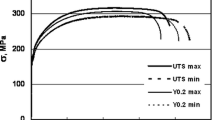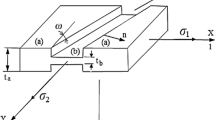Abstract
Today, sheet metal process simulations based finite element (FE) analysis became an indispensable part of tool design engineering in automotive and related stamping industries. In this context, an analytical description of the inherent directional strength and deformation variations in these sheet metals are conducted by means of an orthotropic yield criterion. In practice, an appropriate criterion can be determined using directionality parameters such as r-values and yield stress ratios from simple tension tests to predict material strength and deformation anisotropies analytically. When yield criteria together with the computed anisotropy parameters are implemented into the finite element software, however, it should be also investigated whether the finite element (FE) model could capture the actual anisotropic behavior of the material and assess the analytical model accurately. One way of ensuring this condition is to use single finite element tests in order to simulate uniaxial deformation behavior of material in simple tensile tests. In this study, FE analyses of simple tension test with sheet specimens were conducted for specimens from seven evenly spaced directions for two widely used sheets in the automotive industry, namely DP600 and AA2090-T3 aluminum alloy. Lankford parameters and the yield stress ratios were predicted with analytical approach and FE analysis for different material orientations. It is determined that, while plasticity model analyses are quite successful in terms of computed deformations and flow curves, Barlat’s yield functions family has significant strength and deformation differences between analytical and numerical results, especially for steel sheets. It is assessed that these discrepancies are caused by plasticity implementation into FE software.








Similar content being viewed by others
References
Firat M (2008) A numerical analysis of sheet metal formability for automotive stamping applications. Comput Mater Sci. https://doi.org/10.1016/j.commatsci.2008.01.068
Hill R (1948) A theory of the yielding and plastic flow of anisotropic metals. Proc R Soc London Ser A. https://doi.org/10.1098/rspa.1948.0045
Chung K, Ma N, Park T, Kim D, Yoo D, Kim C (2011) A modified damage model for advanced high strength steel sheets. Int J Plast. https://doi.org/10.1016/j.ijplas.2011.01.007
Woodthrope J, Pearce R (1970) The anomalous behavior of aluminum sheet under balanced biaxial tension. Int J Mech Sci. https://doi.org/10.1016/0020-7403(70)90087-1
Banabic D, Müller W, Pöhlandt K (1998) Determination of yield loci from cross tensile tests assuming various kinds of yield criteria. Sheet Metal Forming Beyond 2000, Brussels, Belgium
Hill R (1979) Theoretical plasticity of textured aggregates. Math Proc Cambridge Philos Soc. https://doi.org/10.1017/S0305004100055596
Hill R (1990) Constitutive modelling of orthotropic plasticity in sheet metals. J Mech Phys Solids. https://doi.org/10.1016/0022-5096(90)90006-P
Hill R (1993) A user-friendly theory of orthotropic plasticity in sheet metals. Int J Mech Sci. https://doi.org/10.1016/0020-7403(93)90061-X
Banabic D (2010) Sheet metal forming processes constitutive modelling and numerical simulation, Cluj–Napoca, Romania
Gotoh M (1977) A theory of plastic anisotropy based on a yield function of fourth order (plane stress state). Int J Mech Sci. https://doi.org/10.1016/0020-7403(77)90043-1
Soare SC (2007) On the use of homogeneous polynomials to develop anisotropic yield functions with applications to sheet forming. Dissertation, University of Florida
Barlat F, Lian J (1989) Plastic behavior and stretchability of sheet metals part 1 a yield function for orthotropic sheets under plane stress conditions. Int J Plast. https://doi.org/10.1016/0749-6419(89)90019-3
Barlat F, Lege DJ, Brem JC (1991) A six component yield function for anisotropic materials. Int J Plast. https://doi.org/10.1016/0749-6419(91)90052-Z
Yoon JW, Barlat F, Chung K, Pourboghrat F, Yang DY (2000) Earing predictions based on asymmetric nonquadratic yield function. Int J Plast. https://doi.org/10.1016/S0749-6419(99)00086-8
Barlat F, Brem JC, Yoon JW, Chung K, Dick RE, Lege DJ, Pourboghrat F, Choi SH, Chu E (2003) Plane stress yield function for aluminum alloy sheets—part 1: theory. Int J Plast. https://doi.org/10.1016/S0749-6419(02)00019-0
Hershey AV (1954) The plasticity of an isotropic aggregate of anisotropic face centered cubic cyristal. J Appl Mech ASME 21:241–249
Hosford WF (1979) On yield loci of anisotropic cubic metals. In: Proceedings of the 7th North American Metalworking Conference (NMRC) Dearborn, 191–197
Bassani JL (1977) Yield characterization of metals with transversaly isotropic plastic properties. Int J Mech Sci. https://doi.org/10.1016/0020-7403(77)90070-4
Toros S, Polat A, Oztırk F (2012) Study on the definition of equivalent plastic strain under non-associated flow rule for finite element formulation. Mater Des. https://doi.org/10.1016/j.matdes.2012.05.006
Xu L, Barlat F, Lee MG (2012) Hole expansion of twinning-induced plasticity steel. Scripta Materilia. https://doi.org/10.1016/j.scriptamat.2012.01.062
Kuwabara T, Mori T, Asano M, Hakoyama T, Barlat F (2017) Material modeling of 6016-O and 6016–T4 aluminum alloy sheets and application to hole expansion forming simulation. Int J Plast. https://doi.org/10.1016/j.ijplas.2016.10.002
Alaie A, Kadkhodapour J, Rad SZ, Asadabad MA, Schmauder S (2015) Formation and coalescence of strain localized regions in ferrite phase of DP600 steels under uniaxial tensile deformation. Mater Sci & Eng A. https://doi.org/10.1016/j.msea.2014.11.042
Aşık EE, Perdahçıoğlu PS, van den Boogard AH (2019) Microscopic investigation of damage mechanisms and anisotropic evolution of damage in DP600. Mater Sci & Eng A. https://doi.org/10.1016/j.msea.2018.10.018
Darabi AC, Guski V, Butz A, Kadkhodapour J, Schmauder SA (2020) Comparative study on mechanical behavior and damage scenario of DP600 and DP980 steels. Mech of Mater. https://doi.org/10.1016/j.mechmat.2020.103339
Hu Q, Li X, Han X, Li H, Chen J (2017) A normalized stress invariant-based yield criterion: Modeling and validation. Int J Plast. https://doi.org/10.1016/j.ijplas.2017.09.010
Hu Q, Li X, Chen J (2017) On the calculation of plastic strain by simple method under nonassociated flow rule. Europ J Mech A/Solids. https://doi.org/10.1016/j.euromechsol.2017.08.017
Pham QT, Lee MG, Kim YS (2021) New procedure for determining the strain hardening behavior of sheet metals at large strains using the curve fitting method. Mech of Mater. https://doi.org/10.1016/j.mechmat.2020.103729
Safaei M, Yoon JW, De Waele W (2014) Study on the definition of equivalent plastic strain under non-associated flow rule for finite element formulation. Int J Plast. https://doi.org/10.1016/j.ijplas.2013.09.010
Standard ASTM (2011) E8/E8M. Stand. test meth. Tens. Test. Metal. Mater. 3:66
Belytschko T, Lin JI, Chen-Shyh T (1984) Explicit algorithms for the nonlinear dynamics of shells. Comp Met App Mech Eng. https://doi.org/10.1016/0045-7825(84)90026-4
Funding
Not applicable
Author information
Authors and Affiliations
Corresponding author
Ethics declarations
Conflicts of interest
The author's declared that they have no conflict of interest.
Additional information
Technical Editor: João Marciano Laredo dos Reis.
Publisher's Note
Springer Nature remains neutral with regard to jurisdictional claims in published maps and institutional affiliations.
Rights and permissions
About this article
Cite this article
Esener, E., Akşen, T.A., Ünlü, A. et al. On the prediction of strength and deformation anisotropy of automotive sheets for stamping formability analysis. J Braz. Soc. Mech. Sci. Eng. 43, 551 (2021). https://doi.org/10.1007/s40430-021-03276-y
Received:
Accepted:
Published:
DOI: https://doi.org/10.1007/s40430-021-03276-y




